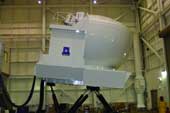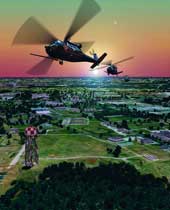A new and improved virtual world

The imagined becomes real as improved simulators find wider use as training tools.
When an attempt to rescue U.S. hostages in Iran in April 1980 failed and caused the deaths of eight U.S. servicemen, the Army put a renewed emphasis on its helicopters and their pilots.Post-mission investigations led to several conclusions. One significant finding was that the military needed helicopter pilots who were highly skilled at flying in difficult conditions: At night, in bad weather or for long periods.So the Army created the 160th Special Operations Aviation Regiment, which flies highly modified helicopters, to fulfill that need.From the beginning, the Army used simulators as a training tool for the 160th unit. But as technology has improved, the realism and versatility that simulators can provide have improved dramatically.Today, simulators using databases that contain satellite images and other data are creating sophisticated mission rehearsals. The technology allows the military to quickly create scenarios and train pilots, said David Graham, director of Special Operations Forces Programs at CAE, a provider of simulation and modeling technologies based in Saint-Laurent, Quebec."When you look at the images in the simulator, they look very, very real," he said. "If you didn't know you were in a simulator, you might think you're looking at a movie of an airplane in flight."The use of databases to create realistic images and other conditions also hasin-flight applications. Chelton Flight Systems' 3D Synthetic Vision, for example, enables pilots to see a realistic image of their surroundings regardless of weather or darkness.The system creates a realistic view in which the ground and obstacles are depicted as brown and the sky is blue, drawing real-time data from the aircraft's Global Positioning System gear, flight sensors and onboard topographical databases. The electronic display reduces instrument scanning and pilot fatigue by consolidating readings of several instruments into one view.In another application, Honeywell won a Defense Advanced Research Projects Agency contract to develop and integrate synthetic-vision technology to improve helicopter landings in poor visibility. Honeywell was selected by Sikorsky Aircraft Corp. to develop the technology for DARPA's Sandblaster program.Under the $6.9 million, 18-month contract, Honeywell will design and demonstrate a synthetic-vision system for Black Hawk helicopter cockpits. The technology integrates radar-based sensor information with terrain and obstacle data to provide a detailed 3-D view. Using it, pilots will not need to see outside reference points to land safely.Honeywell expects to market the technology commercially by 2010.For the Army's 160th Special Operations Aviation Regiment, realistic simulators enable pilots to train for specific missions in a highly detailed way not previously available."Flight simulators traditionally have been used for flight training," Graham said. "But there is the whole other application we call mission rehearsal. If you are going to use the flight simulator for mission rehearsal, then you're much more concerned with making it as close as you can to the real world in terms of what it looks like out the window and what it looks like inside the helicopter."Before CAE started working with the Army four years ago, one of the major limitations the Army faced was that the database it used to create mission rehearsals could show only the view seen outside the helicopter's window. The pilot could see simulated terrain and buildings, but the simulators could not recreate the sensors, gauges and instruments inside the aircraft.In an ideal mission rehearsal, the pilot would see a radar display that exactly matches the terrain, Graham said. But in the past, the needed information resided in separate ? and often proprietary ? databases. Any of the elements could be simulated, but synchronizing them was almost impossible. CAE's technology solved that problem.CAE builds complete simulators for the Army. In response to the need for a more comprehensive view, CAE developed software that uses a centralized database, drawn from Defense Department and intelligence sources, and optimized the hardware that runs the simulators.With the new technology, CAE and DOD created database standards that DOD now owns."We couldn't have done that a few years ago because the hardware just wasn't fast enough," Graham said. "You need fast computers and broadband networks to make this work."Also, because of limited address space, going from one local database to another in the past meant having to pause the simulation to unload one set of data and load another. The new standard is capable of accommodating the whole world in its addressing scheme."Now, more-capable hardware eliminates that problem," Graham said. "The concept of this standard is [that] the whole world will be modeled. Some of the world will be at very high resolution, and some of the world will be at lower resolution."


Virtual space in the real world
Crash safely, in a simulator
Staff writer Doug Beizer can be reached at dbeizer@1105govinfo.com.

CAE builds flght simulators for the Army.

A virtual image of Black Hawk helicopters flying at sunset
Photos courtesy of CAE
Virtual space in the real world
Crash safely, in a simulator
Staff writer Doug Beizer can be reached at dbeizer@1105govinfo.com.
NEXT STORY: Marines, start your engines!

